jump start Oldsmobile Alero 2003 Owner's Manuals
[x] Cancel search | Manufacturer: OLDSMOBILE, Model Year: 2003, Model line: Alero, Model: Oldsmobile Alero 2003Pages: 354, PDF Size: 16.74 MB
Page 180 of 354
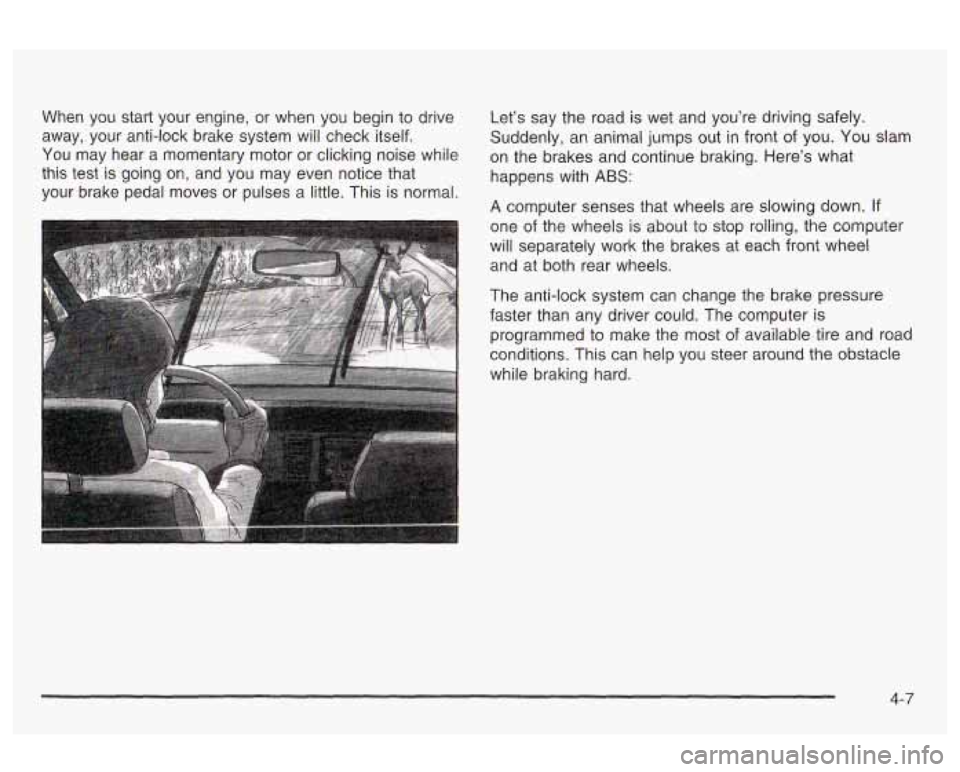
When you start your engine, or when you begin to drive
away, your anti-lock brake system will check itself.
You may hear a momentary motor or clicking noise while
this test
is going on, and you may even notice that
your brake pedal moves or pulses a little. This is normal. Let’s say the road
is wet and you’re driving safely.
Suddenly, an animal jumps out in front of you. You slam
on the brakes and continue braking. Here’s what
happens with ABS:
A computer senses that wheels are slowing down. If
one of the wheels is about to stop rolling, the computer
will separately work the brakes at each front wheel
and at both rear wheels.
The anti-lock system can change the brake pressure
faster than any driver could. The computer is
programmed to make the most of available tire and road
conditions. This can help you steer around the obstacle
while braking hard.
4-7
Page 216 of 354
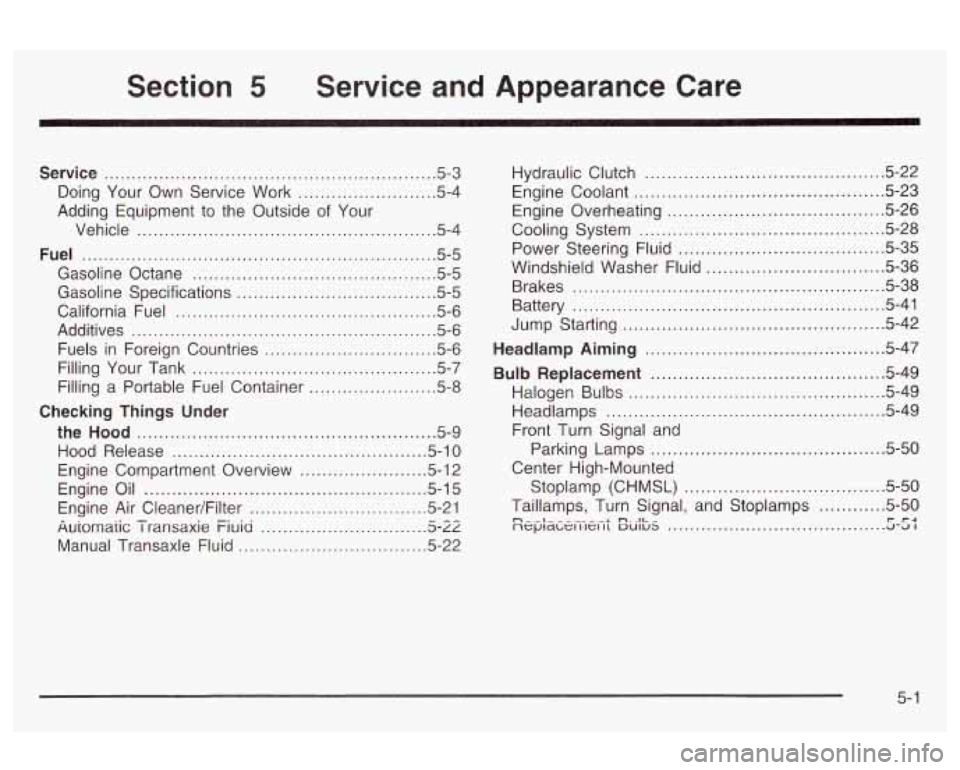
Section 5 Service and Appearance Care
Service ........................................................... -5-3
Doing Your Own Service Work ......................... 5.4
Adding Equipment to the Outside
of Your
Vehicle
..................................................... -5-4
Fuel
............................................................... -5-5
Gasoline Octane ........................................... -5-5
Gasoline Specifications .................................... 5.5
California Fuel .............................................. -5-6
Additives
...................................................... -5-6
Fuels in Foreign Countries
.............................. -5-6
Filling Your Tank
..................................... 5-7
Fillins a Portable Fuel Container .. ...... 5.8
the Hood
...................................................... 5-9
Hood Release .............................................. 5-10
Engine Compartment Overview ....................... 5-12
Engine Oil
.................................................. -5-1 5
Au'romaiic Transaxie Fiuia A-LL
Manual Transaxle Fluid .................................. 5-22
Checking
Things Under
Engine Air CleanedFilter
................................ 5-21 - ^^ .............................
Hydraulic Clutch ........................................... 5-22
Engine Overheating
....................................... 5-26
Cooling System
............................................ 5-28
Power Steering Fluid
..................................... 5-35
Windshield Washer Fluid
............ ............ -5-36
Brakes
...................................................... -5-38
Battery
........................................................ 5-41
Jump Starting
.............................................. 5-42
Engine Coolant
............................................. 5-23
Headlamp Aiming
........................................... 5-47
Bulb Replacement .......................................... 5-49
Haloger;
!3L;lbs .............................................. 5-49
Headlamps .................. .... ......... 5-49
Front Turn Signal and
Parking Lamps
.......... ......... 5-50
Center High-Mounted Stoplamp (CHMSL)
.................................... 5-50
Taillamps, Turn Signal, and Stoplamps ............ 5-50 n-.-~ n ..II-- nepmwzIIIe111 DUIU~ J-J 1 rc4 .......................................
5- 1
Page 256 of 354
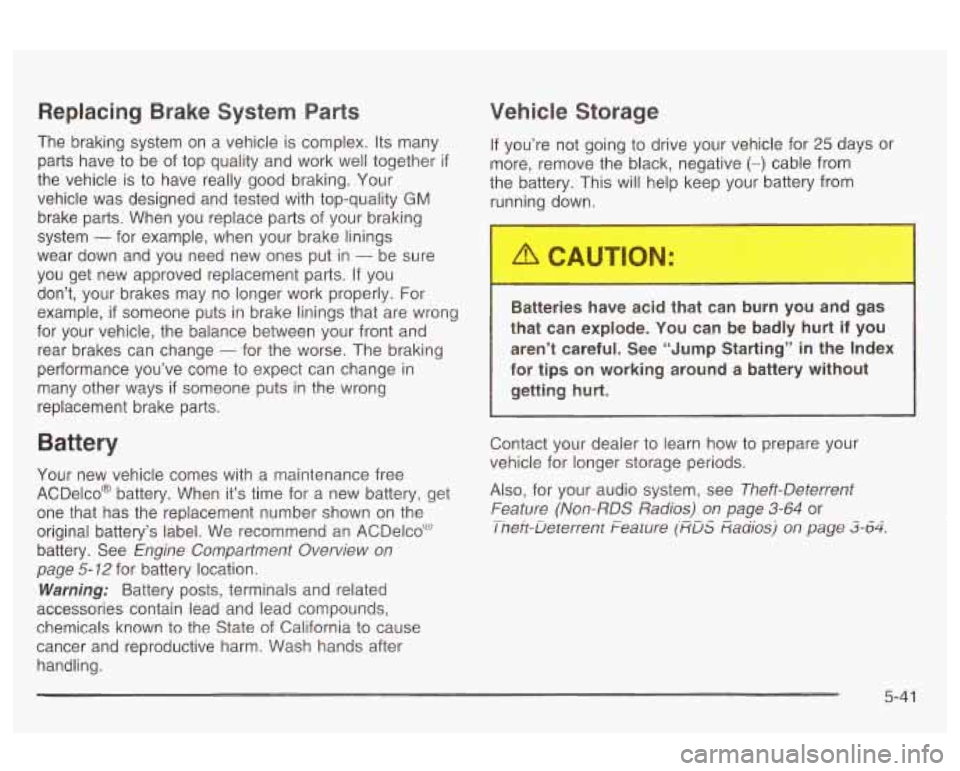
Replacing Brake System Parts
The braking system on a vehicle is complex. Its many
parts have
to be of top quality and work well together if
the vehicle is to have really good braking. Your
vehicle was designed and tested with top-quality
GM
brake parts. When you replace parts of your braking
system
- for example, when your brake linings
wear down and you need new ones put in
- be sure
you get new approved replacement parts. If you
don’t, your brakes may no longer work properly. For
example,
if someone puts in brake linings that are wrong
for your vehicle, the balance between your front and
rear brakes can change
- for the worse. The braking
performance you’ve come
to expect can change in
replacement brake parts.
many other ways if someone puts in the wrong
Battery
Your new vehicle comes with a maintenance free
ACDelco@ battery. When it’s time for a new battery, get
one that has the replacement number shown on the
original battery’s label. We recommend an ACDelcoC”-‘
battery. See
Engine Compartment Overview on
page
5- 12 for battery location.
Warning; Battery posts, terminals and related
accessories contain lead and lead compounds,
chemicals known to the State of California to cause
cancer and reproductive harm. Wash hands after
handling.
Vehicle Storage
If you’re not going to drive your vehicle for 25 days or
more, remove the black, negative
(-) cable from
the battery. This will help keep your battery from
running down.
Batteries have acic bat can burn you and gas
that can explode. You can be badly hurt
if you
aren’t careful. See “Jump Starting” in the Index
for tips
on working around a battery without
I 3--L ’ =
rrnttjqrr hl Irt.
Contact your dealer to learn how to prepare your
vehicle for longer storage periods.
Also, for your audio system, see
Theft-Deterrent
Feature (Non-RDS Radios) on page
3-64 or
I nefi-Deterrent Feature (RDS RaQiosj on page 3-64. -.
5-41
Page 257 of 354

Jump Starting
If your battery has run down, you may want to use
another vehicle and some jumper cables to start your
vehicle. Be sure to follow the steps below to do it safely.
I- Ba..,ries can hi.- - you. ’_ --?y cal. Je c-.lgerous
because:
They contain acid that can burn you.
They contain gas that can explode or
They contain enough electricity to
ignite.
burn you.
If you don’t follow these steps exactly, some
or all of these things can hurt you.
Notice: Ignoring these steps could result in costly
damage to your vehicle that wouldn’t be covered
by your warranty.
Trying to start your vehicle by pushing or pulling
it
won’t work, and it could damage your vehicle.
1. Check the other vehicle. It must have a 12-volt
battery with a negative ground system.
Notice: If the other system isn’t a 12-volt system
with a negative ground, both vehicles can be
damaged.
2. Get the vehicles close enough so the jumper cables
can reach, but be sure the vehicles aren’t touching
each other.
If they are, it could cause a ground
connection you don’t want.
You wouldn’t be able to
start your vehicle, and the bad grounding could
damage the electrical systems.
To avoid the possibility of the vehicles rolling, set
the parking brake firmly on both vehicles involved in
the jump start procedure. Put an automatic
transaxle in PARK (P) or a manual transaxle in
NEUTRAL before setting the parking brake.
Notice: If you leave your radio on, it could be badly
damaged. The repairs wouldn’t be covered by
your warranty.
3. Turn off the ignition on both vehicles. Unplug
unnecessary accessories plugged into the cigarette
lighter. Turn
off the radio and all lamps that aren’t
needed. This will avoid sparks and help save
both batteries. And it could save your radio!
4. Open the hoods and locate the batteries. Find the
positive
(+) and negative (-) terminal locations on
each vehicle. See
Engine Compartment Overview
on page
5-12 for more information on location.
5-42
Page 258 of 354
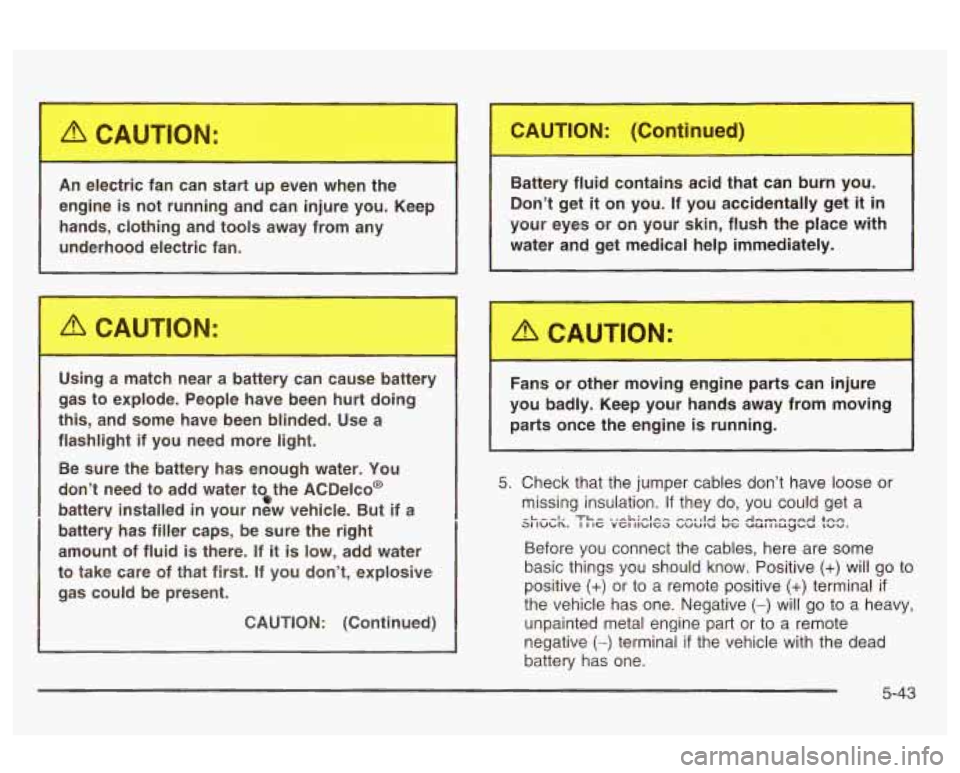
An electric fan can start up even wt.-.r the
engine
is not running and can injure you. Keep
hands, clothing and tools away from any
underhood electric fan.
m rn
Using a match near a battery can cause battery
gas to explode. People have been hurt doing
this, and some have been blinded. Use a
flashlight if you need more
light.
Be sure the battery has enough water. You
don’t need to add water tsthe ACDelco@
battery installed
in your new vehicle. But if a
battery has filler caps, be sure the right
amount of fluid
is there. If it is low, add water
to take care of that first. If you don’t, explosive
gas could be present.
CAUTION: (Continued) Battery fluid contains acid that can
burn you.
Don’t get
it on you. If you accidentally get it in
your eyes or on your skin, flush the place with
water and get medical help immediately.
I Fans or other moving el,,,ne parts can ..., ure
you badly. Keep your hands away from moving
parts once the engine
is running.
5. Check that the jumper cables don’t have loose or
missing insulation.
If they do, you could get a
SI Iucln. I I IC VCIIICIIG~ UWUIU UG UCAIIIUY~U CUW. -L--I- TI-- ..-L.:-1-,. mA,,lA Lm An-mmr.P4 tnn
Before you connect the cables, here are some
basic things you should know. Positive
(+) will go to
positive
(+) or to a remote positive (+) terminal if
the vehicle has one. Negative (-) will go to a heavy,
unpainted metal engine part or to a remote
negative
(-) terminal if the vehicle with the dead
battery has one.
5-43
Page 261 of 354
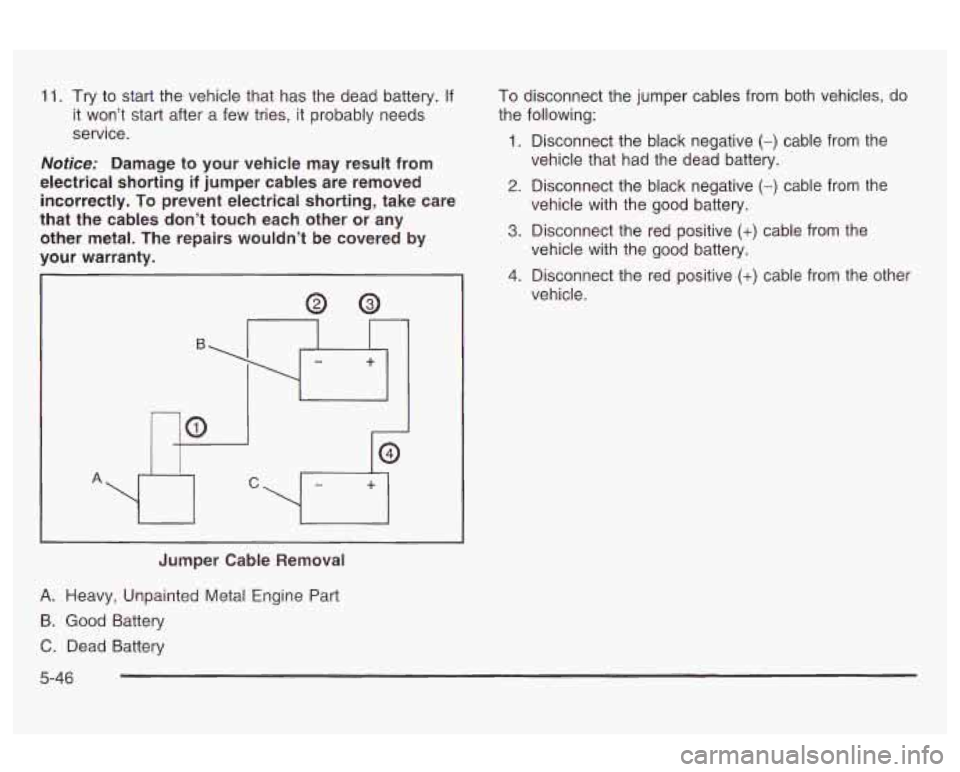
11. Try to start the vehicle that has the dead battery. If
it won’t start after a few tries, it probably needs
service.
Notice: Damage to your vehicle may result from
electrical shorting
if jumper cables are removed
incorrectly. To prevent electrical shorting, take care
that the cables don’t touch each other or any
other metal. The repairs wouldn’t be covered by
your warranty.
I
Jumper Cable Removal
A. Heavy, Unpainted Metal Engine Part
6. Good Battery
C. Dead Battery
To disconnect the jumper cables from both vehicles, do
the following:
1. Disconnect the black negative (-) cable from the
vehicle that had the dead battery.
2. Disconnect the black negative (-) cable from the
3. Disconnect the red positive (+) cable from the
vehicle with
the good battery.
vehicle with the good battery.
1.. Disconnect the red positive (+) cable from the other
vehicle.
5-46
Page 327 of 354
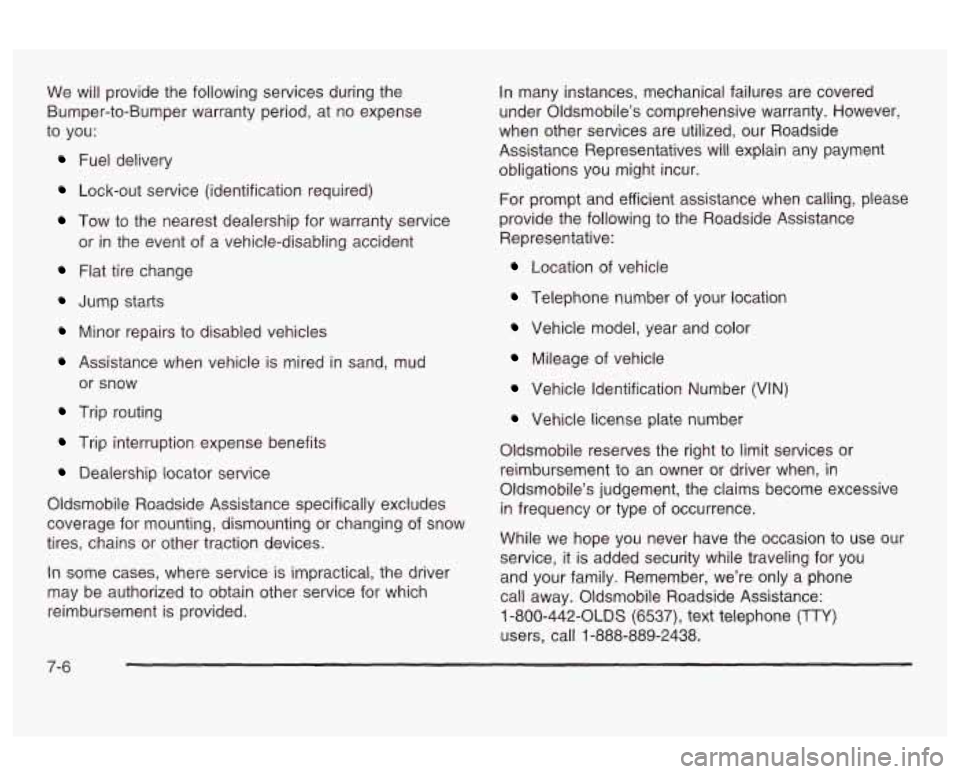
We will provide the following services during the
Bumper-to-Bumper warranty period, at no expense
to you:
Fuel delivery
Lock-out service (identification required)
Tow to the nearest dealership for warranty service
or in the event of a vehicle-disabling accident
Flat tire change
Jump starts
Minor repairs to disabled vehicles
Assistance when vehicle is mired in sand, mud
or snow
Trip routing
Trip interruption expense benefits
Dealership locator service
Oldsmobile Roadside Assistance specifically excludes
coverage for mounting, dismounting or changing
of snow
tires, chains or other traction devices.
In some cases, where service is impractical, the driver
may be authorized to obtain other service for which
reimbursement is provided. In
many instances, mechanical failures are covered
under Oldsmobile’s comprehensive warranty. However,
when other services are utilized, our Roadside
Assistance Representatives will explain any payment
obligations you might incur.
For prompt and efficient assistance when calling, please
provide the following to the Roadside Assistance
Representative:
Location of vehicle
Telephone number of your location
Vehicle model, year and color
Mileage of vehicle
Vehicle Identification Number (VIN)
Vehicle license plate number
Oldsmobile reserves the right to limit services or
reimbursement to an owner or driver when,
in
Oldsmobile’s judgement, the claims become excessive
in frequency or type of occurrence.
While we hope you never have the occasion to use our
service, it is added security while traveling for you
and your family. Remember, we’re only a phone
call away. Oldsmobile Roadside Assistance:
1 -800-442-OLDS (6537), text telephone (TTY)
users, call 1-888-889-2438.
7-6
Page 340 of 354
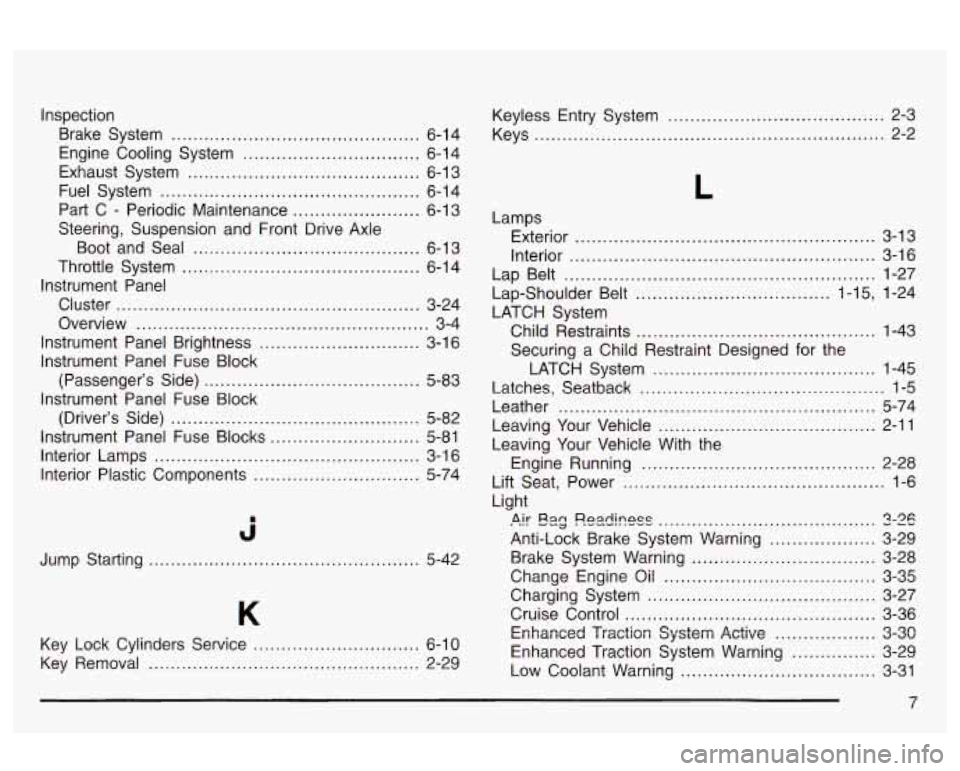
Inspection Brake System
............................................. 6-14
Engine Cooling System
................................ 6-14
Fuel System
............................................... 6-14
Part C
. Periodic Maintenance ....................... 6-13
Steering. Suspension and Front Drive Axle
Boot and Seal
......................................... 6-1 3
Throttle System
.................................... 6-1 4
Cluster
....................................................... 3-24
Overview
..................................................... 3-4
Instrument Panel Brightness
............................. 3-1 6
Instrument Panel Fuse Block
(Passenger's Side)
....................................... 5-83
instrument Panel Fuse Block
(Driver's Side)
............................................. 5-82
Instrument Panel Fuse Blocks
........................... 5-81
Exhaust System
.......................................... 6-13
Instrument Panel
Interior Lamps
................................................ 3-16
Interior Plastic Components
.............................. 5-74
J
Jump Starting ................................................. 5-42
Key Lock Cylinders Service
.............................. 6-10
Key Removal
................................................. 2-29 Keyless
Entry System
....................................... 2-3
Keys
............................................................... 2-2
L
Lamps
Exterior
............ .... ........ 3-13
Interior
....................................................... 3-16
Lap Belt
........................................................ 1-27
Lap-Shoulder Belt
................................... 1.15. 1-24
LATCH System Child Restraints
........................................... 1-43
Securing a Child Restraint Designed for the
LATCH System
........................................ 1-45
Latches,
Seatback ............................................ 1-5
Leather ......................................................... 5-74
Leaving Your Vehicle
....................................... 2-11
Leaving Your Vehicle With the
Engine Running
.......................................... 2-28
Lift Seat, Power
....................... ......... 1-6
Light
................................... 3-26
Anti-Lock Brake System Warning ................... 3-29
Brake System Warning
................................. 3-28
Change Engine Oil
...................................... 3-35
Charging System
......................................... 3-27
Cruise Control
............................................. 3-36
Enhanced Traction System Warning
............... 3-29
Low Coolant Warning
................................... 3-31
. A-ir -"a Ran Rnadinncc .V UU ... YYY
LI c+,,,, I talIbGd T;actior; System Active J-JO QQ ..................
7